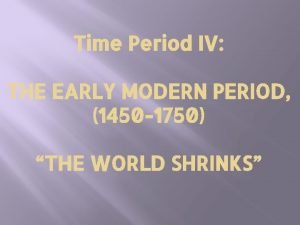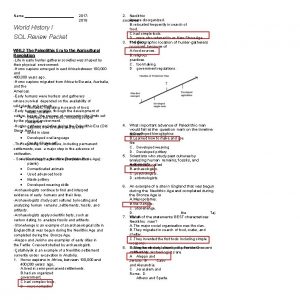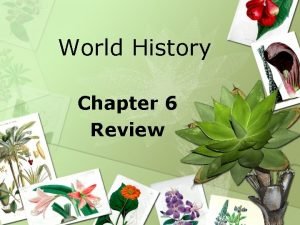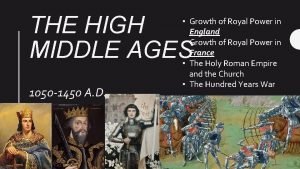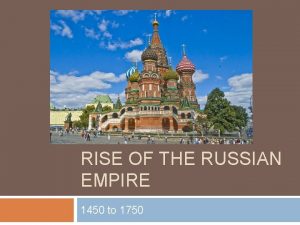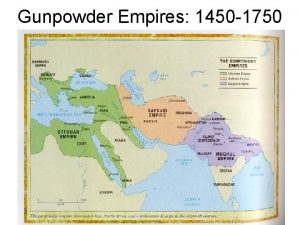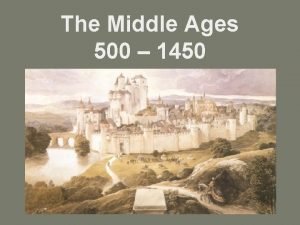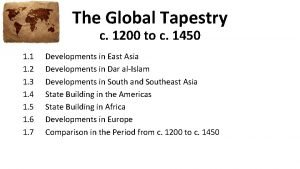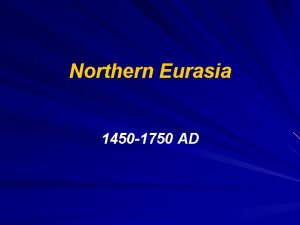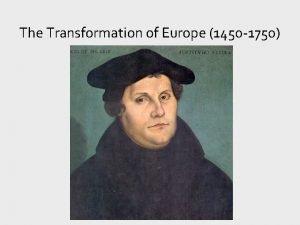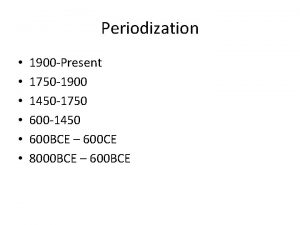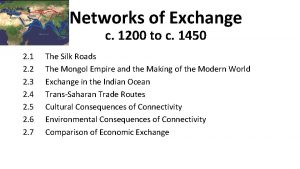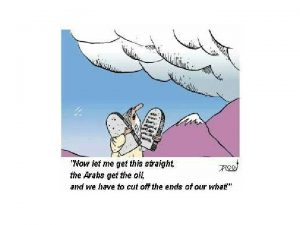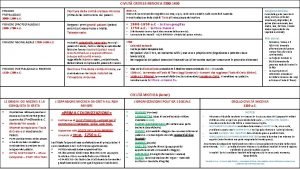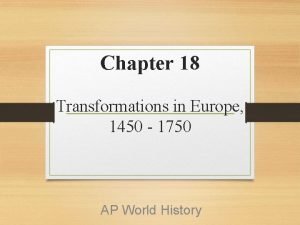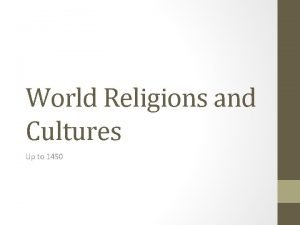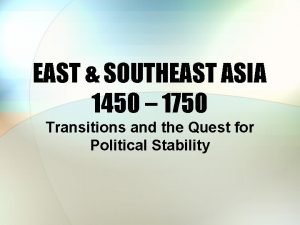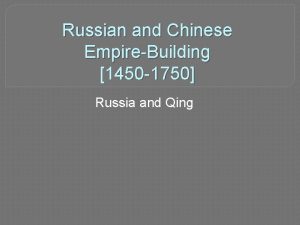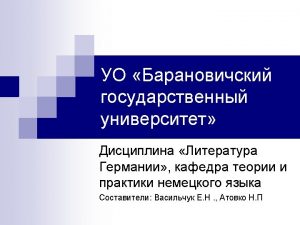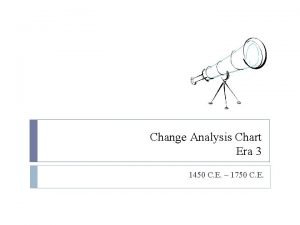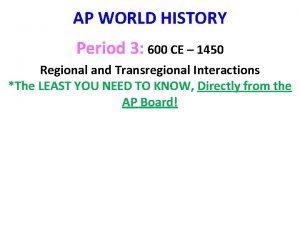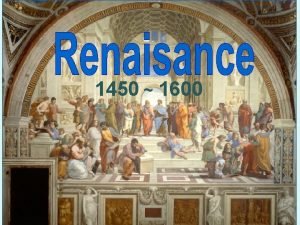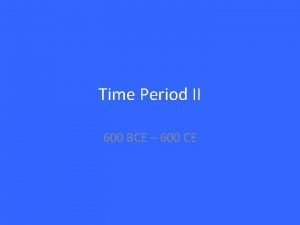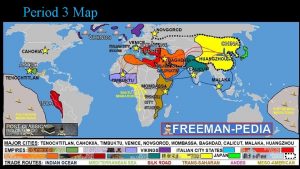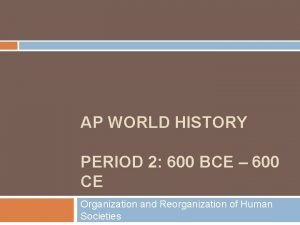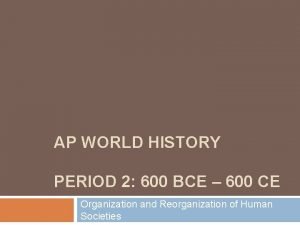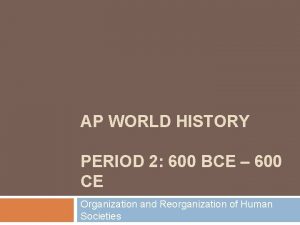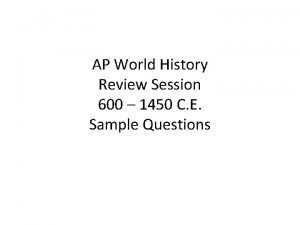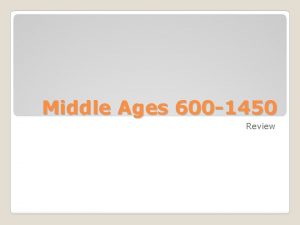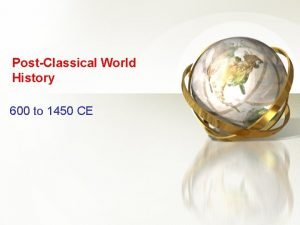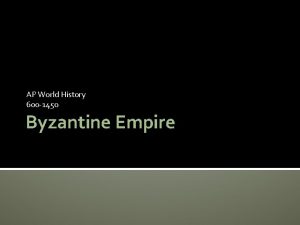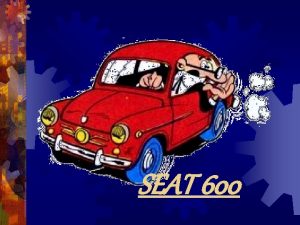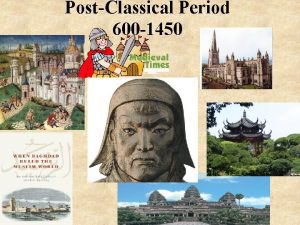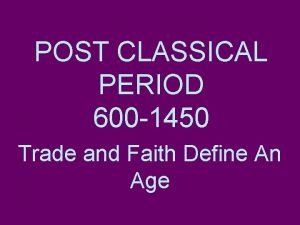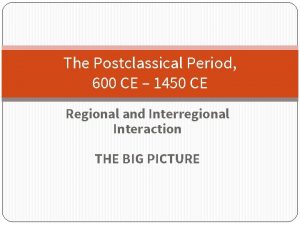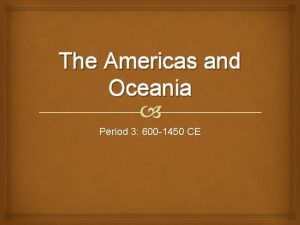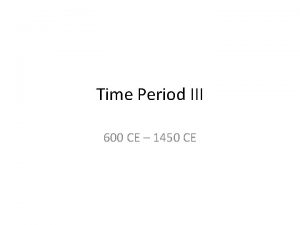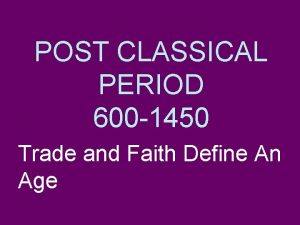AP WORLD HISTORY PERIOD 3 REVIEW 600 1450










































- Slides: 42

AP WORLD HISTORY PERIOD 3 REVIEW 600 – 1450 CE

EXAM STRUCTURE • 55 mins. – 70 multiple choice questions - Break - • 10 mins. – Read essay prompts and plan • 2 hrs. – Write 3 essays • Document Based Question • Continuity & Change Over Time • Comparison

PERIODS • Period 1: 8000 – 600 B. C. E. • Neolithic Revolution, River valley civilizations • Period 2: 600 B. C. E. – 600 C. E. • Greece, Rome, Han, Silk Road • Period 3: 600 – 1450 C. E. • Byzantines, Islam, Indian Ocean Trade • Period 4: 1450 – 1750 C. E. • European Exploration, Renaissance & Reformation • Period 5: 1750 – 1900 C. E. • Revolutions, Industry, Imperialism • Period 6: 1900 – Present • World Wars, Globalization

THEMES (S. P. I. C. E. ) • Social – Gender Roles, Social Classes, Ethnic Groups • Political – Types of Government, Wars, Laws, Revolts • Interaction between Humans and the Environment – Geography, Migration, Technology • Cultural – Religions, Philosophies, Science, Arts • Economic – Trade, Labor Systems, Industrialization

HISTORICAL SOURCES Historians are concerned with the examination of written records from the past. There are two types of sources that historians study: • Primary Source- A firsthand record of a historical event created by an eyewitness who actually experienced the event – (Examples- Diaries, photographs, artifacts, autobiographies) • Secondary Source- A secondhand record of a historical event created by a person who did NOT actually experience the event – (Examples- Textbooks, encyclopedias, biographies)

PERIOD 3 600 – 1450 CE Regional and Transregional Interactions – 20%

BYZANTINE EMPIRE • c. 500 -1453 CE • After the western area of the Roman Empire was conquered by invading Germanic tribes in the year 476 AD, the eastern portion of the Roman Empire survived and became known as the Byzantine Empire.

BYZANTINE EMPIRE • The people of the Byzantine Empire were mainly Greek in language and culture. • Constantinople- The capital city of the Byzantine Empire. It was a great location for trade because it was located along major waterways and it was a crossroads of (link between) Europe and Asia. • Eastern Orthodox Religion- This was the branch of Christianity that was practiced by the people of the Byzantine Empire (the Hagia Sophia was a famous church in Constantinople). • Justinian Code- Written system of laws created by Emperor Justinian that was later adopted by various European civilizations. It was largely based on laws of the Roman Empire). • Preservation of Greek and Roman Culture- The Byzantines preserved (saved) and passed on important texts created by the Greeks and Romans.

BYZANTINE EMPIRE • Cultural Diffusion- The Byzantine Empire had a major influence on the neighboring civilization of Russia. – The Eastern Orthodox Religion (which is still practiced in Russia today) – The Cyrillic Alphabet (writing system still used in Russia today)

LEGAL SYSTEMS SO FAR • Code of Hammurabi- Written set of laws used in ancient Mesopotamia. It is known for its harsh punishment of crimes (i. e. “an eye for an eye”). • Twelve Tables of Rome- Written set of laws used in Roman Empire. Laws favored the wealthy. • Justinian Code- Written set of laws used in the Byzantine Empire. It was based on old Roman laws and was later adopted by many countries in Europe. • NOTE: The College Board wants you to know the following about these 3 legal systems: – They are all standardized (written) sets of laws. – They each concern the relationship between the state (government) and the individual. – They all helped create stability (a calm and orderly society) since people were able to learn what the laws were.

ISLAM • Monotheistic religion that believes in one God (called Allah). • Followers of Islam are called Muslims. • Koran (Qu’ran)- The Holy Book of Islam. • Five Pillars- Religious and moral/ethical duties and obligations that are required of all Muslims – Make a pilgrimage to Mecca, pray five times daily, etc. • Muhammad (lived 570 -632 AD) – founder of Islam who was born in Mecca (the holiest city of Islam) – believed by Muslims to be the last of God’s prophets (messengers to the people)

GOLDEN AGE OF ISLAM • 700 – 1200 CE • After Muhammad – Muslim armies swept out of the Arabian peninsula – conquered vast areas of land that included much of the Middle East, the northern coast of Africa, and even southern Spain. • Golden Age - amazing achievements in math, science, medicine, philosophy, and art. Some of the key achievements of this period include: – The creation of medical encyclopedias. – Improvements in math (especially algebra). – Artwork that included calligraphy (beautiful writing), woolen carpets, and textiles.

IBN BATTUTA • 1304 -1369 CE • Born in Morocco • Studied to be a judge • Made a 3000 mile pilgrimage to Mecca • Continued to travel another 72, 000 miles – More than anyone before the introduction of steam engine • Died due to the Black Plague

MIDDLE AGES EUROPE • 400 -1400 CE • The period of time in Europe after the collapse of the Roman Empire and before the Renaissance. • the Roman Catholic Church (especially the Pope) was very wealthy and influential in Western Europe

FEUDALISM • Political system of the Middle Ages in which kings throughout Europe gave land away to nobles in return for their loyalty and military service. • Nobles that received land from the king had to serve as knights (warriors on horseback) and fight when necessary. – Knights had to follow chivalry (a code of behavior that stressed loyalty and bravery) • Decentralized political system because kings gave away much of their power to nobles, who each controlled their own local areas • Land was the basis of wealth and power. Those with more land were considered to be more wealthy and powerful. • Brought social stability, order, and structure to the Middle Ages.

MANORIALISM • During the Middle Ages, most people lived on manors (areas of land owned by a noble). • Each manor had homes, farmland, artisans, water, and serfs (peasants that could not leave the land who performed farm labor for the noble). • Since each manor was mostly self-sufficient (provided for its own needs), trade decreased during the Middle Ages.

CRUSADES • 1100 – 1300 CE • The Crusades were the religious wars of the Middle Ages in which Christians from Europe fought to regain control of the Holy Land from Muslims. – The Holy Land is a sacred area of the Middle East that includes the city of Jerusalem.

CAUSES OF THE CRUSADES • Byzantine Patriarch reached out to the Catholic Pope. • European Christians believed they would be forgiven for their sins if they fought for God. • European Christians believed the Holy Land should not be controlled by Muslims. • Many poor Europeans wanted to escape from feudalism. • Many Europeans hoped to gain wealth from the Middle East.

EFFECTS OF THE CRUSADES • After years of fighting, trade between Europe and the Middle East increased – Italian cities such as Venice gained control over much of this trade since they had a central location in the Mediterranean Sea • Europeans learned about the many achievements that Muslims had made during their Golden Age – math, science, medicine, philosophy, and art • Feudalism in Europe began to decline as many nobles had been killed and many serfs had escaped.

THE BLACK DEATH (1347 -51) • Bubonic plague • Killed 25 million people in Europe (almost 1/3 of the population) during the late Middle Ages. • The disease started in East Asia (maybe China) and spread to Europe over trade routes such as the Silk Road. – The interaction of different groups helped spread the disease. • Major effects (results) of the Black Death: – Depopulation- The population of Europe decreased from 85 million to 60 million. – Feudalism continued to decline as serfs fled from manors for better opportunities. – Trade temporarily decreased.

GOLDEN AGE OF CHINA • The Tang and Song Dynasties (600 s-1200 s) – The Chinese invented gunpowder (which was later adopted by civilizations in Europe and the Middle East). – The Chinese invented the compass (which improved sailing/navigation by sea). – The Chinese invented block printing (a method of printing in which ink is placed on carved wooden blocks that are pressed onto paper). – The Chinese created works of art using porcelain (beautiful clay).

GOLDEN AGE OF CHINA • The Tang and Song Dynasties (600 s-1200 s) – The Chinese conducted long distance trade with other civilizations on land (using the Silk Road) and by sea (from their coastal port city of Canton). – Cultural Diffusion- Buddhism became popular in China during this period as the ideas of this religion entered China due to trade using the Silk Road. – The Chinese continued to use civil service exams to select highly qualified people to work in their government.

JAPAN • located in East Asia and is considered to be an archipelago – a country that consists of a group of islands (Japan is made up of 4 main islands) • a long and irregular (unsmooth/rough) coastline • made up mostly of mountains, which has made farming difficult. • Terrace Farming- In order to farm in the mountains, the Japanese had to dig and carve flat areas (called terraces) into the sides of mountains. – NOTE: The Inca of Peru (in South America) used the same technique.

JAPAN • Shinto is the religion of Japan. – a religion (similar to Animism in Africa) that believes all living and non-living things in nature (such as trees, mountains, rivers, animals, etc. ) have a spirit • Later in Japan’s history, Buddhism became popular as well. • Today, most Japanese practice both Shinto and Buddhism.

JAPAN • Cultural Diffusion- Early Japan was GREATLY influenced by contact with the neighboring Asian civilization of China. • Through contact with China, Japan received many important things: – Writing- Japan’s first form of writing was influenced by Chinese writing. – Buddhism- The Japanese learned about the Buddhist religion from the Chinese. – Tea- The Japanese first learned how

JAPANESE FEUDALISM • Similar to Europe during the Middle Ages, Japan developed a system of feudalism early in its history. • The feudal system worked like this: – Emperor and Shogun (military general)- the rulers of Japan. – Daimyo- They were the wealthy nobles who were given land by the emperor and Shogun in return for loyalty and military service. – Samurai- They were the warriors of Japanese society. They pledged loyalty to the Daimyo and had to fight when necessary. • had a code of behavior called Bushido (which required the samurai to be loyal to the Daimyo and to fight bravely in battle).

JAPANESE FEUDALISM • NOTE: Japanese feudalism was very similar to European feudalism: – Japanese samurai and European knights both followed a code of behavior. Bushido was the code of the Samurai and Chivalry was the code of the knights. Both codes emphasized loyalty and bravery. – Japanese and European feudalism were both decentralized, which means that power was given to many different local leaders instead of being concentrated in the hands of a single ruler. – Because people in each society had a clear role to follow, feudalism brought structure, order, and stability (calmness) to society.

AFRICA • Africa has a very diverse (varied) geography – deserts (i. e. - the Sahara Desert) – savanna (grasslands) – rainforests • Due to its many geographic features, Africa is a very diverse continent with many different cultures. • NOTE: Africa is currently having problems with desertification (the spreading of desert lands). The Sahara continues to grow, which

AFRICA • Animism is the traditional religion that is native to Africa. • It is a religion (similar to Shinto in Japan) that believes all living and non-living things in nature (such as trees, mountains, rivers, animals, etc. ) have a spirit.

SWAHILI COAST • Indian Ocean Trade brought Arab Muslim traders • Arab traders settled and took Bantu wives • Arab & Bantu culture and language blended

WEST AFRICA CIVILIZATIONS • 300 - 1400 s CE • Three of Africa’s greatest civilizations all developed in West Africa – Ghana – Mali – Songhai • NOTE: Ghana, Mali, and Songhai all grew very wealthy for the same reason: They were located along the Trans-Saharan trade routes and participated in the Gold-Salt trade (i. e. - they traded their gold for

MANSA MUSA • He was the most famous ruler of Mali. • He is important for several reasons: – He was a devoted Muslim who helped spread Islam in West Africa. – He made a pilgrimage to Mecca in Saudi Arabia. – He turned the city of Timbuktu into a center of trade and Islamic learning.

MONGOLS • 1100 s – 1400 s CE • The Mongol people originated on the steppes (grassy plains) of Central Asia. • The Mongols lived in a harsh physical environment and survived as nomadic pastoralists – They raised animals and migrated frequently in search of grazing lands for their animals.

MONGOLS • Under the skilled military leadership of Genghis Khan, the Mongols conquered so much land that they established the LARGEST EMPIRE in all of history. • At its height, the Mongol empire included – China – Central Asia – Russia – much of the Middle East

MARCO POLO • Italian merchant who visited the Mongols in China and remained there for almost 20 years. • After returning to Italy, Marco wrote down extensive information about his experiences in China with the Mongols. • NOTE: The writings of Marco Polo are important for several reasons: – They are valuable primary sources that teach us about China during this period. – They increased the desire of Europeans to trade with China to obtain valuable goods.

MONGOLS • Trade and travel between Europe and Asia increased TREMENDOUSLY during Mongol rule since the Mongols kept peace and prevented violence along trade routes (Silk Road). • Influence on Russia – After they conquered Russia, the Mongols kept Russia isolated (removed) from developments that were taking place in Western Europe. – The Mongols taught the Russians how to have a centralized government- A strong government with one ruler in firm control. • The first foreign group to completely conquer China. • The Mongols developed a tribute system – Areas taken over by the Mongols were required to give the Mongols money each year

600 -1450 TRAVELERS • The College Board likes to ask questions about these men – Marco Polo- Italian merchant who traveled to China (over the Silk Road) when it was ruled by the Mongols. – Ibn Battuta- Arab/Muslim explorer who traveled a total of 75, 000 miles and visited lands in Africa, Asia, and Europe. – Zheng He- Chinese explorer of the Ming Dynasty who sailed the Indian and Pacific Oceans to lands that included Southeast Asia, India, the western coast of Africa. • These three individuals are important for several reasons: – They wrote extensively about their travels. These writings are valuable primary sources that teach us about lands that they visited. – The contacts they made with other lands helped stimulate trade between different regions of the world.

DBQ TOPICS DBQ 2002 Christian & Muslim Attitudes Toward Merchants & Trade • Using the documents, compare and contrast the attitudes of Christianity and Islam toward merchants and trade from the religions’ origins until about 1500. Are there indications of change over time in either case, or both? What kinds of additional documents would you need to assess the consequences of these attitudes on merchant activities?

CCOT TOPICS CCOT 2009 Silk Roads 200 BCE-1450 CE • Analyze continuities and changes in patterns of interactions along the Silk Roads from 200 B. C. E. to 1450 C. E. CCOT 2012 Afro-Eurasian Trade Networks • Analyze continuities and changes in trade networks between Africa and Eurasia from circa 300 C. E. to 1450 C. E.

CCOT TOPICS CCOT 2013 Political Transformations in the Mediterranean • Analyze how political transformations contributed to continuities and changes in the cultures of the Mediterranean region during the period circa 200 C. E. to 1000 C. E.

COMPARATIVE TOPICS C&C 2005 Effects of Mongols • Compare and contrast the political and economic effects of Mongol rule on TWO of the following regions: – China – Middle East – Russia

COMPARATIVE TOPICS C&C 2011 Rise of Empires • Analyze similarities and differences in the rise of TWO of the following empires. – A West African Sudanic empire (Mali OR Ghana OR Songhay) – The Aztec Empire – The Mongol Empire
 Ap world history period 3
Ap world history period 3 World map 1450
World map 1450 Trigonometri
Trigonometri Ap world history period 2 test
Ap world history period 2 test World history spring final exam review answers
World history spring final exam review answers World history 1 sol review
World history 1 sol review World history semester 2 final review packet
World history semester 2 final review packet Us history semester exam review answers
Us history semester exam review answers Hellenistic doctors increased their knowledge by
Hellenistic doctors increased their knowledge by Chemistry fall semester exam review answers
Chemistry fall semester exam review answers World history 1st semester final review answers
World history 1st semester final review answers Ap world history jeopardy review game
Ap world history jeopardy review game World history final exam study guide
World history final exam study guide Ap world history chapter 25 africa and the atlantic world
Ap world history chapter 25 africa and the atlantic world Bad world tour
Bad world tour Mughal empire 1450 to 1750
Mughal empire 1450 to 1750 1450 ad
1450 ad Kznu
Kznu Fur trade 1450 to 1750
Fur trade 1450 to 1750 Russian empire 1450-1750
Russian empire 1450-1750 Cultural exchange between nomads and non nomads before 1450
Cultural exchange between nomads and non nomads before 1450 Land based empires 1450 to 1750
Land based empires 1450 to 1750 500/1450
500/1450 The global tapestry from c.1200 to c.1450
The global tapestry from c.1200 to c.1450 Japan 1450-1750
Japan 1450-1750 Europe 1450
Europe 1450 1750+600
1750+600 Adopalen
Adopalen 1250 bc
1250 bc Prepalaziale
Prepalaziale Europe map 1750
Europe map 1750 Agean art
Agean art Religion 1450-1750
Religion 1450-1750 Southeast asia 1450 to 1750
Southeast asia 1450 to 1750 St basil's cathedral ap world history
St basil's cathedral ap world history Renaissance 1450 to 1600
Renaissance 1450 to 1600 Naturalismus historischer hintergrund
Naturalismus historischer hintergrund Change analysis chart 1450 to 1750
Change analysis chart 1450 to 1750 Critical period vs sensitive period
Critical period vs sensitive period A&p flix activity: resting membrane potential
A&p flix activity: resting membrane potential Is hyperpolarization the same as refractory period
Is hyperpolarization the same as refractory period Critical period vs sensitive period
Critical period vs sensitive period Critical period vs sensitive period
Critical period vs sensitive period

